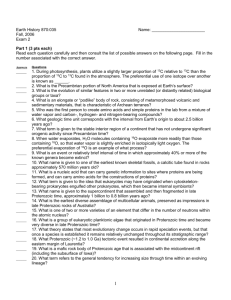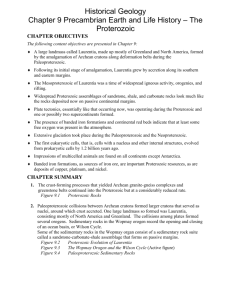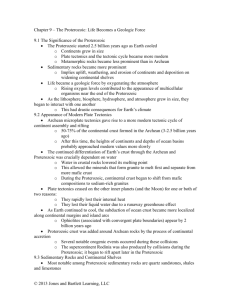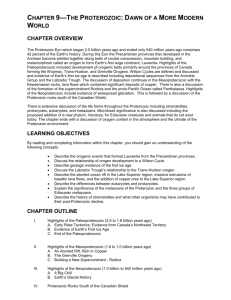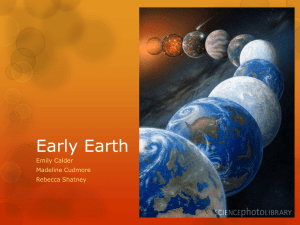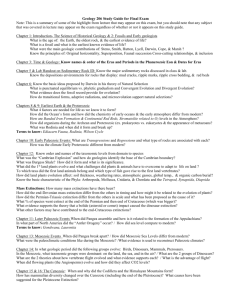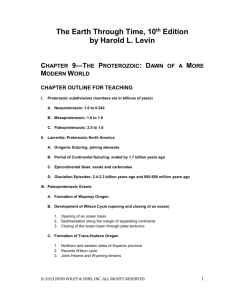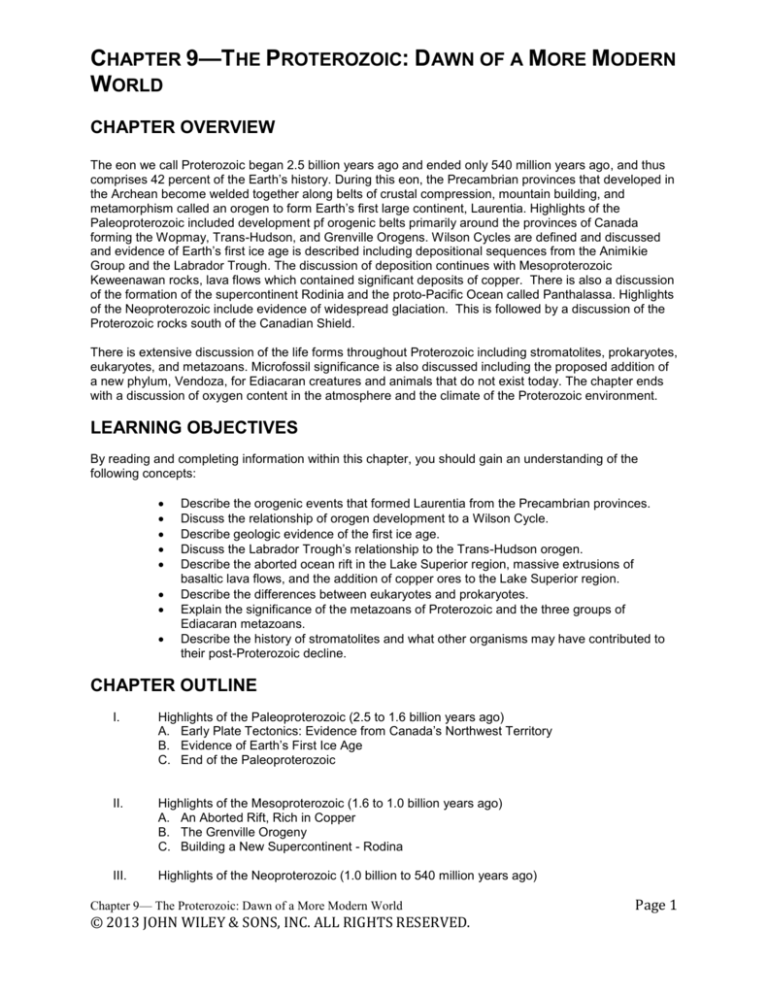
CHAPTER 9—THE PROTEROZOIC: DAWN OF A MORE MODERN
WORLD
CHAPTER OVERVIEW
The eon we call Proterozoic began 2.5 billion years ago and ended only 540 million years ago, and thus
comprises 42 percent of the Earth’s history. During this eon, the Precambrian provinces that developed in
the Archean become welded together along belts of crustal compression, mountain building, and
metamorphism called an orogen to form Earth’s first large continent, Laurentia. Highlights of the
Paleoproterozoic included development pf orogenic belts primarily around the provinces of Canada
forming the Wopmay, Trans-Hudson, and Grenville Orogens. Wilson Cycles are defined and discussed
and evidence of Earth’s first ice age is described including depositional sequences from the Animikie
Group and the Labrador Trough. The discussion of deposition continues with Mesoproterozoic
Keweenawan rocks, lava flows which contained significant deposits of copper. There is also a discussion
of the formation of the supercontinent Rodinia and the proto-Pacific Ocean called Panthalassa. Highlights
of the Neoproterozoic include evidence of widespread glaciation. This is followed by a discussion of the
Proterozoic rocks south of the Canadian Shield.
There is extensive discussion of the life forms throughout Proterozoic including stromatolites, prokaryotes,
eukaryotes, and metazoans. Microfossil significance is also discussed including the proposed addition of
a new phylum, Vendoza, for Ediacaran creatures and animals that do not exist today. The chapter ends
with a discussion of oxygen content in the atmosphere and the climate of the Proterozoic environment.
LEARNING OBJECTIVES
By reading and completing information within this chapter, you should gain an understanding of the
following concepts:
Describe the orogenic events that formed Laurentia from the Precambrian provinces.
Discuss the relationship of orogen development to a Wilson Cycle.
Describe geologic evidence of the first ice age.
Discuss the Labrador Trough’s relationship to the Trans-Hudson orogen.
Describe the aborted ocean rift in the Lake Superior region, massive extrusions of
basaltic lava flows, and the addition of copper ores to the Lake Superior region.
Describe the differences between eukaryotes and prokaryotes.
Explain the significance of the metazoans of Proterozoic and the three groups of
Ediacaran metazoans.
Describe the history of stromatolites and what other organisms may have contributed to
their post-Proterozoic decline.
CHAPTER OUTLINE
I.
Highlights of the Paleoproterozoic (2.5 to 1.6 billion years ago)
A. Early Plate Tectonics: Evidence from Canada’s Northwest Territory
B. Evidence of Earth’s First Ice Age
C. End of the Paleoproterozoic
II.
Highlights of the Mesoproterozoic (1.6 to 1.0 billion years ago)
A. An Aborted Rift, Rich in Copper
B. The Grenville Orogeny
C. Building a New Supercontinent - Rodina
III.
Highlights of the Neoproterozoic (1.0 billion to 540 million years ago)
Chapter 9— The Proterozoic: Dawn of a More Modern World
© 2013 JOHN WILEY & SONS, INC. ALL RIGHTS RESERVED.
Page 1
Chapter 9—The Proterozoic: Dawn of a More Modern World
A. A Big Chill
B. Earth’s Glacial History
IV.
Proterozoic Rocks South of the Canadian Shield
A. Grand Canyon Precambrian Rocks
V.
Proterozoic Life
A. Microfossils of the Gunflint Chert
B. The Rise of Eukaryotes
C. Acritarchs
D. Many-Celled Animals Arrive: The Metazoans
E. Ediacaran Fauna
F. The Vendoza Controversy
G. What the Ediacaran Fossils Tell Us About the Proterozoic
H. Oxygen and Climate Changes in the Proterozoic Environment
Chapter 9— The Proterozoic: Dawn of a More Modern World
© 2013 JOHN WILEY & SONS, INC. ALL RIGHTS RESERVED.
Page 2
Chapter 9—The Proterozoic: Dawn of a More Modern World
KEY TERMS
(pages given in parentheses)
acritarchs (265): Unicellular, spherical microfossils with resistant single-layered walls. Useful in
correlating Proterozoic strata. First appear in rocks about 1.6 million years old. Reached maximum
diversity and abundance 850 million years ago and then suffered a steady decline which coincided with
the major episode of glaciation underway near the end of Proterozoic.
Animikie Group (257): Paleoproterozoic rocks surrounding the western shores of Lake Superior are
included in this group; famous for its bonanza iron ore content. Coarse sandstones and conglomerates
deposited in shallow water lie near the base of the Animikie Group. These rocks are overlain by cyclic
successions of chert, cherty limestone, shales, and banded iron formations.
coelum (267): In Kimberella, a body cavity in which the digestive tract and other internal organs are
suspended.
cyanobacteria (257): Formerly known as blue-green algae. These fossils suggest that oxygen-producing
organisms had already evolved by an early age (Archean Eon) in Earth history. Microfossils were found in
a chert bed that occurs within the Apex Basalt Formation of the Warrawoona Group.
dropstone (259): Chunks of rock released from melting icebergs.
Ediacaran fauna (266): Impressions of large, soft-bodied animals. The best-known fossils of
Neoproterozoic metazoans found in the Rawnsley Quartzite of the Pound Subgroup. According to their
shape, they fall into three groups, discoidal, frond-like, and ovate to elongate. Discoidal forms such as
Cyclomedusa were initially thought to be jellyfish. Another circular form, Tribrachidium, appears to have
no modern counterpart and may be a member of an extinct phylum. Frond-like fossils resemble the
living soft corals informally called sea pens. They look rather like fronds of ferns, except that tiny coral
polyps are aligned along the branchlets. Ovate to elongate were originally regarded as impressions
made by flatworms and annelid worms. Typical of these fossils is Dickinsonia, which attained lengths of
up to a meter, and Springgina, a more slender animal with a distinctive crescent-shaped structure at its
anterior end.
epicontinental (253): A shallow, inland sea that flooded the continental interiors.
Grenville orogeny (259): Orogenic event that occurred 1.2 to 1.0 billion years ago in eastern Canada.
Typical Grenville rocks consist of carbonates and sandstones that have been metamorphosed and
intruded by igneous bodies. In eastern Canada, these rocks have been compressed into overturned folds
that have northeasterly axes.
Hudsonian orogeny (257): The event that separates Paleoproterozoic from Mesoproterozoic geologic
history. It was a period of intense folding, metamorphism, and westward thrust faulting.
Keweenawan (258): Clean quartz sandstones and conglomerates as well as basaltic volconics that rest
on either crystalline basement or Animikian strata that extended from the Lake Superior region southward
beneath cover of Phanerozoic rocks.
Labrador Trough (257): A curving, elongate structural depression found east of the Superior province
where there is an extensive outcrop of rocks.
Laurentia (253): A large continent formed during Proterozoic by the welding of Archeon elements. (The
Superior, Slave, Hearne, Rae, Wyoming, and Nain provinces.)
metazoan (266): Multicellular animals that possess more than one kind of cell and have their cells
organized into tissues and organs.
Chapter 9— The Proterozoic: Dawn of a More Modern World
© 2013 JOHN WILEY & SONS, INC. ALL RIGHTS RESERVED.
Page 3
Chapter 9—The Proterozoic: Dawn of a More Modern World
Mesoproterozoic (251): The middle part of Proterozoic, approximately 1.6 to 1.0 billion years ago.
molecular fossil (265): Biochemical remnants of microfossils, i.e. eukaryotes, that are chemical clues to
early life forms.
Neoproterozoic (251): The youngest part of Proterozoic, approximately 1.0 billion years ago to the
beginning of the Paleozoic Era, 540 million years ago.
orogen (253): Belt of crustal compression, mountain building, and metamorphism.
Paleoproterozoic (251): The early part of Proterozoic, approximately 2.5 to 1.6 billion years ago.
Precambrian province (253): The divisions of the Canadian Shield based on differences in the trends of
faults and folds, the style of folding, and the ages of component rocks.
red beds (271):
Rodinia (251): Supercontinent found by the gathering of continents during Neoproterozoic. One of the
most significant global events of Neoproterozoic.
tillite (256): Unsorted glacial deformation (till) that has been converted into solid rock. Used as a
paleoclimatic indicator of glaciation.
varves (254): A thin sedimentary layer or pair of layers that represent the depositional record of a single
year.
Vendobionta (269): New name given to the Vendoza to avoid confusion with the Russian time term
Vendoza.
Vendoza (269): A separate taxonomic category proposed for Ediacaran creatures with dissimilarities to
animals that exist today and possessing their own unique characteristics. One view suggests that they
should not be placed in existing phyla. Also, a name used in Russia for the final period of
Neoproterozoic.
Wilson Cycle (254): Sequence of events including the opening of an ocean basin, sedimentation along
resulting new continental margins, and closure of the ocean basin through plate tectonic processes.
Named after J. Tuzo Wilson, one of the pioneers of the plate tectonics theory.
Chapter 9— The Proterozoic: Dawn of a More Modern World
© 2013 JOHN WILEY & SONS, INC. ALL RIGHTS RESERVED.
Page 4
Chapter 9—The Proterozoic: Dawn of a More Modern World
MULTIPLE-CHOICE QUESTIONS
1.
The eon that began 2.5 billion years ago and ended 544 million years ago and contains 42 percent
of the earth’s history is the
a. Neoproterozoic.
c. Proterozoic.
b. Archean.
d. Hadean.
2.
The sequence of orogenic events in the Canadian Shield during Proterozoic, from youngest to
oldest, is
a. Wopmay, Hudsonian, and Grenvillian.
c. Hudsonian, Grenvillian, and Wopmay.
b. Grenvillian, Hudsonian, and Wopmay.
d. Grenvillian, Wopmay, and Hudsonian.
3.
Opening of an ocean basin, sedimentation along continental margins, and closure of ocean through
plate tectonic process is called
a. an orogeny.
c. the Wilson cycle.
b. uniformitarianism.
d. suturing.
4.
Glaciation during Early Proterozoic is recorded by conglomerates and laminated mudstone of the
a. Animikie Group.
c. Gunflint Chert.
b. Gowganda Formation.
d. Belt Supergroup.
5.
Laminated mudstones that record yearly variations in sediment flux are called
a. greenstones.
c. varves.
b. granulites.
d. tillites.
6.
The gathering of continents during Neoproterozoic formed a supercontinent named
a. Pangea.
c. Iapetus.
b. Rodinia.
d. Mirovia.
7.
The “Vishnu” represents the oldest rock unit at the Grand Canyon and is an example of a
a. sandstone.
c. slate.
b. schist.
d. granite.
8.
The oldest rocks in the Grand Canyon region are the
a. Grand Canyon series.
c. Belt Supergroup.
b. Vishnu Schist.
d. Animikie Group.
9.
The Trans-Hudsonian orogeny records the closure and suturing of the
a. North American plate to the Greenland plate.
b. Superior province to the Hearne and Wyoming province.
c. North American plate to the South American plate.
d. North American plate to the African plate.
10.
The rocks of the Proterozoic that contain the oldest evidence of two continental glaciers are
a. Autcogen and Wopmay.
c. Gowganda and Huronian.
b. Rhiphaen and Mazatal.
d. Gowganda and Varangian.
11.
Unicellular, spherical microfossils with resistant single-layered walls that are useful in correlating
Proterozoic strata are termed
a. acritarchs.
c. metazoans.
b. eukaryotes.
d. heliotrophs.
12.
One of the first eukaryote unicellular, spherical microfossils with resistant single-layered walls is
a. algae.
c. cyanobacteria.
Chapter 9— The Proterozoic: Dawn of a More Modern World
© 2013 JOHN WILEY & SONS, INC. ALL RIGHTS RESERVED.
Page 5
Chapter 9—The Proterozoic: Dawn of a More Modern World
b. stromatolites.
d. acritarchs.
13.
The generic (genus) name given to the star-shaped fossils found in the 3.5 billion year old
(Archean) Gunflint chert is
a. Gunflintia.
c. Cyclomedusa.
b. Acritarchs.
d. Eoastrion.
14.
During this orogeny, the east coast of Laurentia (North America) lay adjacent to a block of western
South America termed Amazonia.
a. Greenville
c. Varanglan
b. Gowgande
d. Hudsonian
15.
The Vishnu Schist of the Grand Canyon of the southwestern U.S. was emplaced 1.4 – 1.3 billion
years ago as part of what orogeny?
a. Mazatzal orogeny
c. Trans-Hudson orogeny
b. Wopmay orogeny
d. Grenville orogeny
16.
The Varagean glaciation which is described as a period of extensive glaciation as evidenced by the
tillites, dropstones, and varied clays occurred during
a. Neoprotozoic.
c. Paleoproterozoic.
b. Grenville.
d. Mesoproterozoic.
17.
This Paleoproterozoic orogenic belt lies along the western margin of the Slave province in
Canada’s Northwest Territory and is the oldest.
a. Wopmay orogen
c. Grenville orogen
b. Hudson orogen
d. Gowganda orogen
18.
The Superior province that welded (joined) the Hearne and Wyoming provinces during
a. Grenville orogen.
c. Trans-Hudson orogen.
b. Wopmay orogen.
d. Keweenawan.
19.
The eon we call Proterozoic began about how many billion years ago?
a. 3.5
c. 2.5
b. 3.0
d. 2.0
20.
The Proterozoic cyclic succession of the banded iron formations is
a. quartz sandstones, arkoses, conglomerates, basalts.
b. pillow lavas, basalts, mafic intrusives.
c. quartz, conglomerates, shales, banded iron.
d. cherts, cherty limestone, shales, banded iron.
Chapter 9— The Proterozoic: Dawn of a More Modern World
© 2013 JOHN WILEY & SONS, INC. ALL RIGHTS RESERVED.
Page 6
Chapter 9—The Proterozoic: Dawn of a More Modern World
FILL IN THE BLANK
1.
The large supercontinent formed during Early Proterozoic that was essentially what we now call
North America was called
.
2.
The sequence of events given as evidence of the opening of an ocean basin, sedimentation along
continental margins, and the subsequent closure of this basin is called
_______________________________.
3.
The oldest rocks in the Grand Canyon region are called the
4.
A thin sedimentary layer or pair of layers that represent the depositional record of a single year is
called a
.
5.
The orogeny that separates Early Proterozoic from Mesoproterozoic geologic history is called
.
6.
The formation where glaciation during Early Proterozoic is recorded by conglomerates and
laminated mudstones is called
.
7.
The oldest recorded exposures of prokaryotes occur in the now famous rock unit known as
.
8.
The most significant event of the late Proterozoic that was the gathering of Precambrian continents
to form the large supercontinent was called
.
9.
Episodes of Proterozoic glaciation are indicated by the presence of
.
deposits.
10.
The term that is given the unicellular, spherical microfossils with resistant, single-layered walls is
.
11.
The orogen that began with opening of an oceanic rift, progressed to the deposition of continental
shelf and is located along the western margin of the slave provinces in Canada’s Northwest
Territories is called
Orogen.
12.
Evidence for the oxidizing atmosphere is indicated in the geologic record of Proterozoic by the
presence of
.
13.
East of the Superior province, along a curving, is an elongate structural depression called the
_____________ ______________.
14.
Unsorted, lithified glacial debris are called
15.
are multicellular animals that possess more than one kind
of cell and have their cells organized into tissues and organs.
Chapter 9— The Proterozoic: Dawn of a More Modern World
© 2013 JOHN WILEY & SONS, INC. ALL RIGHTS RESERVED.
.
Page 7
Chapter 9—The Proterozoic: Dawn of a More Modern World
TRUE/FALSE
1.
At the beginning of Proterozoic (2.5 billion years ago) many of the smaller elements of
the Archean came together to form Laurentia.
2.
The sequence of orogens in the Canadian Shield in order of oldest to youngest is
Wopmay, Trans-Hudson, and Grenville.
3.
The Animikie Group that surrounds the western shores of Lake Superior is world famous
for their copper ores.
4.
The Gowganda Formation, a rock unit, is notable because of its surface magma that
cooled and solidified to form ultramafic rocks.
5.
Banded iron deposits are important because of their mineral resources that reflect the
build-up of sufficient oxygen in the atmosphere to oxidize iron.
6.
Life at the beginning of Proterozoic resembled that of Late Archean because it consisted
of prokaryotes such as cyanobacteria.
7.
Strata of the Belt Supergroup contain reef-like masses of stromatolites.
8.
East of the Superior province along a curving is an elongate structural depression called
the Keweenawan Trough are Paleoproterozoic rocks.
9.
The Hudson Orogeny marks the close of Paleoproterozoic.
10.
The most significant biological event of Neoproterozoic was the appearance of the
multicellular animals called metazoans.
Chapter 9— The Proterozoic: Dawn of a More Modern World
© 2013 JOHN WILEY & SONS, INC. ALL RIGHTS RESERVED.
Page 8
Chapter 9—The Proterozoic: Dawn of a More Modern World
ANSWER KEY
Multiple Choice
1. c
2. b
3. c
4. b
5. c
6. b
7. b
8. b
9. b
10. d
11. a
12. d
13. d
14. a
15. a
16. a
17. a
18. c
19. c
20. d
Fill Ins
1.
2.
3.
4.
5.
6.
7.
8.
9.
10.
11.
12.
13.
14.
15.
Laurestia
Wilson cycles
Vishua schist
varve
Hudsonian Orogen
Gowganda
Gunflint Chert
Rodira
tillites
acritarchs
Wopmy
red beds
Labrador Trough
tillites
Metazoans
Chapter 9— The Proterozoic: Dawn of a More Modern World
© 2013 JOHN WILEY & SONS, INC. ALL RIGHTS RESERVED.
True/False
1.
2.
3.
4.
5.
6.
7.
8.
9.
10.
T
T
F
F
T
T
T
F
T
T
Page 9
Chapter 9—The Proterozoic: Dawn of a More Modern World
RESPONSES TO QUESTIONS ACCOMPANYING SELECTED FIGURES
FIGURE 9–3 (p. 254) The faults beneath the turbidites are normal (tensional) faults. These faults are
associated with the passive margins of tectonic plates.
FIGURE 9–7 (p. 257) Hematite serves as the red pigment in the banded iron formations.
FIGURE 9–15 (p. 262) A nonconformity separates the Vishnu Schist and Zoroaster Granite from the
sedimentary sequence of the overlying Grand Canyon Supergroup.
FIGURE 9–28 (p. 268) Kimberella shows evidence of a true coelum, or body cavity, in which a complete
digestive tract and other internal organs can be suspended.
Chapter 9— The Proterozoic: Dawn of a More Modern World
© 2013 JOHN WILEY & SONS, INC. ALL RIGHTS RESERVED.
Page 10

